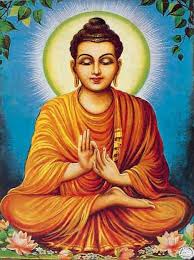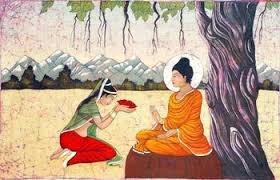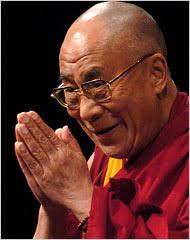
1.) What was the name of the man who later became the Buddha and founded the religion of Buddhism?
The founder of Buddhism was Siddhartha Gautama.
2.) What were the four passing sights? Explain their significance to the origins of Buddhism.
The Four Passing Sights:
1.
Age: Siddhartha, while on his first trip outside the palace, passed by a decrepit old man. As he had never seen old age before, he was greatly troubled when he realized that this fate in store for everyone, including himself.

2.
Sickness/ Disease: On his second trip outside the palace, he saw a diseased man, and again was greatly disturbed by this. He could not understand how people could enjoy life when disease posed a constant threat for them.
3.
Death: On his third trip, he saw a corpse for the first time. This devistated him more than the other two sights, as this showed him that death is inevitable for all things. These first three sights were lessons about the reality of suffering, and "the impertanent nature of life's pleasures".
4.
Asceticism: This fourth passing sight gave Siddhartha hope. The wandering ascetic that passed by him showed Siddhartha that there was a way to overcome the despair that the first three sights brought. It was this last sight that prompted him to leave his palace and begin a life of homelessness.
-These four sights prompted Siddhartha to put an end to old age and death, which brought suffering and saddness to all who experienced it. These four sights created the basis for the religion of Buddhism.

3.) Explain the doctrine of the Middle Way.
The Middle Way:
After Siddhartha left the palace, he joined a group of ascetics that practiced fasting. Siddhartha practiced with them for six years, and pushed himself to the brink of starvation. Then one day, he came across a man teaching his son to restring a mandolin. The man told his son that he could not tie the strings too loose, or else it would not play, however if they were too tight then they would break. The key to creating the best sound was to find a balance between the two. It was this that made Siddhartha realize the key to a successful life, was balance. The teaching that he instilled rejected both the pleasures of sensual indulgence and the self- denial of asceticism, and "focused instead on a practical approach to spiritual attainment".

4.) Describe the event of Gautama's attainment of enlightenment.
The Buddha's Enlightenment:
Siddhartha Gautama meditated under several different teachers. He then took up ascetic practices, which were based on te belief that one could free the spirit by "denying the flesh". He practiced this so determinedly, that he almost starved to death. After these practices failed to enlighten him (on the meaning of life), "he abandoned this way, and looked instead into his own heart and mind." "He decided to trust his intuition and learn from direct experience." He sat underneath a pipal tree and vowed to remain there until he gained enlightenment. He stayed there forty days and finally on the full moon in May, Siddhartha (the Buddha), attained "Ultimate Freedom". For the remainder of his life, the Buddha traveled through Northern India, and spread his understanding and teachings.
5.) What is the Sangha? Who are it's members?
The Sangha is the Buddhist community of monks and nuns. It is one of the three jewels of Buddhism.
6.) What are the three jewels of Buddhism?
The Three Jewels of Buddhism:
1.
The Buddha (the yellow jewel)
2.
The Dharma (the Blue Jewel)
3.
The Sangha (the Red Jewel)
"The ideals at the heart of Bu
ddhism are collectively known as the "Three Jewels", (also known as "the Three Treasures".). By having these central principles in your life, you become a Buddhist.
7.) What features of Buddhist cosmology are shared with Hinduism?
8.) Describe the Buddha's reaction to early Hinduism.
9.) Identify the Three Marks of Existence. How are the interrelated?
The Three Marks of Existence:
1.
Anatta (no- self)
2.
Anicca (impermanence)
3.
Dukkha (suffering)
These three marks are all characteristics that summarize the "changing nature of reality".
10.) What is the doctrine of
anatta? How does it relate to the concept of Hinduism?
The doctrine of
anatta states that there is no permanent self. It is one of the three marks of existence in Buddhism.
11.) According to the Buddhist doctrine of
samsara, what is actually reborn? Explain the role of
karma in the Buddhist understanding of
samsara.
In Buddhism,
samsara is the rebirth of a person's soul after one of their lives on earth is at an end. This doctrine means that although the body of the person is gone, the soul of the person is able to come back to life in a different form (as an animal, etc.).
12.) List the Five Precepts, which apply to all Buddhists. Then list the fice additional precepts that apply to monks and nuns.
The Five Precepts:
1. They cannot steal.
2. They cannot harm living things.
3. They cannot lie.
4. They cannot take part in sexual conduct.
5. They cannot drink intoxicating drinks.
13.) What are some possible English transitions of the term
dukkha? Explain it's meaning in your own words.
Dukkha means "suffering", "fustration", "dislocation", or "discomfort". It is the first of the Four Noble truths as well as one of the three marks of existence in Buddhism.
14.) What is
tanha?
How is it related to
dukkha?
Tanha is the second of the Four Noble Truths. It means "desire", "thirst" or "craving".
Tanha is selfish desire, and it is the cause of
dukkha, ultimate suffering.
15.) List the steps of the Eightfold Path.
The Noble Eightfold Path:
1.) Right Understanding or Perfect Vision
2.) Right Judgement or Perfect Emotion
3.) Right Speech or Perfect Speech
4.) Right Action or Perfect Action
5.) Right Livelihood or Perfect Livelihood
6.) Right Effort or Perfect Effort
7.) Right Mindfulness or Perfect Awareness
8.) Right Meditation or Perfect Samadhi.
The Noble Eightfold Path is a "further unpacking" of (an expansion of ) the Threefold Way. This path is the most widely known of the Buddha's teachings.
16.) What is the difference between the Buddha and the other humans who attain enlightenment?
17.) Define and briefly describe the character of an
arhat.
An
arhat is "one who has become enlightened". It is the ideal type for Theravada Buddhism. An
arhat is someone who has achieved enlightment and will achieve nirvana at the end of their life on Earth, rather than being reborn into
samsara.

18.) What is the literal meaning of the word
nirvana? How does this help explain the concept of
nirvana?
19.) What are the three divisions of Buddhism?
The Three Divisions of Buddhism:
1.
Theravada (Way of the Elders)
2.
Mahayana (Greater Vehicle)
3.
Vajrayana (Tibetan Buddhism)
20.) What is the main focus of Theravada Buddhism?
21.) What is the literal meaning of the name
Mahayana, and what are the implications of this meaning?
22.) How does Vajrayana Buddhism "fight fire with fire"?
23.) Who is the Dalai Lama? How is each Dalai Lama chosen?
The Dalai Lama is the leader of Tibetian Buddhism, in the Vajrayana sect.
24.) What are the primary geographical regions of the three divisions of Buddhism?


